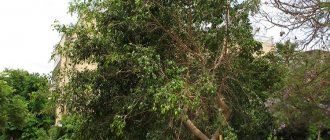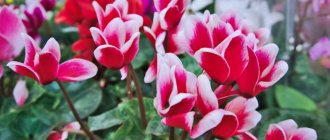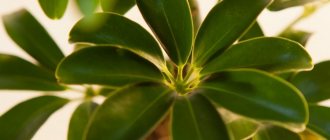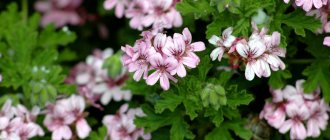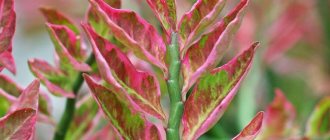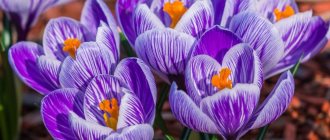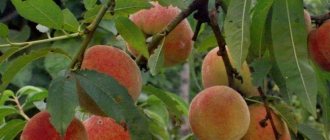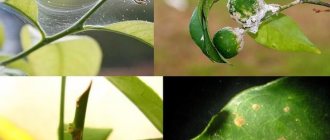The Aralia genus includes more than 35 species of evergreen and deciduous trees and shrubs, which are commonly found in mountainous, coastal and wooded areas of Asia, North and South America.
Representatives of the genus can vary greatly in size, foliage shape, and growing conditions. These can be unremarkable plants or compact decorative foliage aralias, which are in demand in landscape design. Many of the species are covered with spines.
White, pink or greenish-white loose fragrant inflorescences of small flowers abundantly cover a bush or tree during the flowering period. In autumn, the plants are strewn with round black berries.
Botanical description
Herbaceous aralias have hard, thick stems up to 50–60 cm in height, with many spines. Shrubs and trees usually grow up to 5–7 m, occasionally up to 10 m. The trunks are straight, thin, covered with gray bark and studded with thorns. The branches and leaf petioles are also spiny.
The root system is superficial, with many branched shoots located at a depth of up to 60 cm . The lateral branches are short, concentrated closer to the top, the lower parts of the plants remain bare, which makes them look like palm trees. The similarity is enhanced by large, complex leaves: double or triple pinnate, alternately located on short petioles. The leaf blades are bright green, broadly ovate or heart-shaped, with pointed tips.
Aralia blooms late - in mid-summer or August . The flowers are bisexual, small, fragrant, white or cream in color, collected in umbellate sparse inflorescences. The fruits are dark purple or black round berries with several flat, hard seeds and ripen in the fall.
A little history
Until the mid-19th century, there was no plant named Fatsia. The evergreen tree, brought from Japan to Europe, won universal love under the name Aralia japonica. Many people liked the feathery, large, glossy leaves and the non-capricious nature of the plant. Japanese Aralia began to be grown in homes for landscaping shaded areas. However, botanists studying the Araliev family decided to identify a separate genus in 1854 called Fatsia. It included only three species. They differ from other Araliaceae in the special structure of their leaves and inflorescences, and most importantly, in the fact that they are not deciduous, but evergreen plants.
Prevalence
The natural habitat of Aralia species is areas with a tropical climate, subtropics with a sufficient level of moisture. These are Central and South America, the southern states of the USA, regions of Southeast Asia, the Sunda Islands, Japan, China. Small habitats are found in temperate zones of Asia and North America.
In Russia, Aralia is found in the nature of the Far East: Khabarovsk Territory, Amur Region, Primorye, Sakhalin and the Kuril Islands. It grows in deciduous forests, on the edges, in valleys, along river banks, in high mountain areas.
Chemical composition
The medicinal properties of Manchurian aralia are due to the presence of biologically active compounds important for humans in different parts of the plant. The most valuable are the roots, which contain:
- gum;
- resins and tannins;
- starch;
- vitamins (C and group B);
- triterpene saponins (aralosides A, B and C);
- alkaloids (araline);
- minerals (K, Fe, Ca, Mn, Mg, Cu, Zn, Se, etc.);
- flavonoids;
- coumarins;
- proteins;
- essential oil.
Article on the topic: Castor bean - beneficial properties, description
The leaves and branches of the thorn tree contain organic acids, essential oils, anthocyanins, alkaloids, carbohydrates and triterpenoids. The seeds are rich in unsaturated fatty acids.
Kinds
The genus Aralia has more than fifty species, distributed on several continents. Cultivated varieties include several of them:
- Chinese. It grows naturally in southern China, Vietnam and Malaysia. It is a thorny branched shrub or compact tree up to 8 m tall. The leaves are light green, up to 50 cm in size, the blades are pointed, with serrated edges, pubescent on the back side. The inflorescences are white paniculate, the fruits are about 3 mm in size.
- Continental. Far Eastern species: a shrub about 1 m high with a spherical carved crown and large paniculate inflorescences. The leaves are compound pinnate, up to 40–50 cm long, smooth on the upper side and slightly pubescent on the back. The shape of the leaf lobes is heart-shaped. The panicles of the inflorescences are light cream, decorative, up to 30 cm in size. The flowering period begins in August. The black-blue fruits, about 5 mm in diameter, ripen at the end of September.
- Heart-shaped. A large herbaceous shrub, common in China, Korea, Japan and Sakhalin. Stems are bare and tough. The leaves are very large, imparipinnate, and consist of several lobes, elongated to 15–20 cm. The apical plates are wider and heart-shaped. The upper part of the leaves is dark green, the lower part is noticeably lighter. The inflorescences are apical, white, up to 45 cm long, sparse, consisting of a main and several subsidiary umbels. The fruits are small black berries 3–4 mm in size.
- Aralia high or Manchurian. It is found throughout the Russian Far East, China and Japan. A small tree 1.5–5 m high with a spherical crown. The leaves are doubly pinnate, reaching a length of 90–100 cm. The lobar plates are dark green, elliptical, pointed, 10–15 cm in size. The inflorescences are yellowish or white, 25–40 cm in diameter, and consist of several umbrellas. The fruits are black, up to 5 mm in diameter, ripen at the end of September or October. In Russia, the tall aralia is called the devil's tree.
- Bristle Aralia. North American variety, perennial drought-resistant subshrub 70–150 cm high. Stems with thin prickly thorns, creeping roots. The leaves are double-complex pinnate, 20–25 cm long, the lobes are elongated, elliptical, 2x9 cm in size. The inflorescences are yellowish, sparse, paniculate, 7–10 cm in diameter, on thin peduncles. The fruits are purple-black, spherical, about 10 mm in size.
- Aralia spiny. Distributed in southeastern North America. One of the largest species: a moisture-loving tree or bush up to 12–15 m high with a trunk width of 20–30 cm. All parts of the plant are strewn with long, strong thorns. The leaves are dark green, bluish below, very large, up to 1 m long, double and triple pinnate. The lobes are wedge-shaped, with pointed tips, 7–10 cm. The inflorescences are white, 25–30 cm in diameter. The fruits are black achenes, 6–8 mm in size.
Aralia cordate
A popular ornamental variety of the Araliaceae family is cordate aralia (Schmidt's aralia) - a herbaceous perennial plant up to 1.25 m high. In landscape design, it is used in single plantings and in compositions, and a hedge made from it gives the area an exotic look.
The stem, bare below, is erect and, like a tree, does not branch. Thick, with a fleshy and aromatic core, the root is eaten and used in medicine by the Japanese.
Long leaves (up to 50cm) consist of lower lobes of 3-5 leaflets each and simple, very large incised leaflets at the top (2-3 pairs).
The inflorescence (45-55cm in length) in the shape of a panicle has additional inflorescences-tassels, consisting of 5-9 umbrellas. Flowering occurs in late summer - early autumn.
The black fruits are small - 3-4mm, ripen in September - early October.
Application
Umbrella and round carved crowns of aralia with large inflorescences and bright dark fruits look very picturesque in single or group plantings, fitting into any landscape. Plants are planted in gardens as tapeworms, compositions or hedges. During the flowering period, bushes and trees become excellent honey plants.
The roots, leaves and bark of some species are used as raw materials in the pharmaceutical industry. They contain:
- alkaloids;
- essential oils;
- glycosides;
- organic acids;
- triterpene saponins.
For medicinal purposes, tall or bristly aralia is most often used - trees and bushes no younger than 5 years old. Roots and bark are collected in October or early spring. Leaves - in summer, during the flowering period and some time after it.
Active ingredients
The medicinal characteristics of aralia are based on the diverse chemical composition of the plant. Here are the main operating components of culture:
- Starch - quickly reduces cholesterol. Normalizes blood pressure.
- Essential oils – provide antiseptic, anti-inflammatory effects. The plant calms and relieves spasms.
- Phytosterols – promote the production of vitamin D. Steroid hormones and necessary bile acids appear.
- Flavonoids – relieve spasms. The capillaries are strengthened and the heart muscle is nourished. Blood pressure is normalized, it has a diuretic effect, and the blood stops.
- Resins - guarantee antibacterial, mild laxative and wound healing effects.
- Vitamin C is a powerful antioxidant that improves immunity.
- Tanning components – provide an astringent effect, remove inflammation.
Contains vitamins and microelements. The products give an excellent effect.
Medicinal properties
Aralia preparations have a stimulating, cardiotonic, hypoglycemic, gonadotropic effect, stimulate respiration, and improve blood circulation. Tinctures from the roots and leaves of the plant are used for vascular atherosclerosis, hypotension, depressive states, neuroses, asthenovegetative syndrome, concussions, meningitis, and decreased potency in men.
Due to the strong effect of alkaloids and glycosides, it is necessary to use aralia in strictly prescribed dosages. Excessive use of drugs causes intoxication and disruption of the central nervous system.
Contraindication
There are several contraindications to the use of the culture. It is not recommended to use aralia if you have the following problems:
- Epilepsy.
- Sleep problems.
- Exacerbation of arterial hypertension.
- Nervous excitability.
- Manifestations of hyperkinesis.
There is no need to drink the tincture before bed. This may cause insomnia. If you violate the rules of use, if you exceed the dosage, a person will feel nausea, breathing will be impaired, and he may lose consciousness. If symptoms appear, you should stop taking the medications immediately.
Landing
Manchurian aralia (aralia mandshurica) is often used for cultivation for decorative and medicinal purposes. This is the most common variety, has good frost resistance, can withstand long-term temperature drops down to –30 °C and can grow in temperate climates.
For planting, choose sunny or semi-shaded areas with loose, neutral, well-moistened soil . The acidity level should not exceed 6 pH. When choosing a location, take into account the ability to grow quickly and the presence of sharp thorns. The bushes are placed so that there is no need to touch them when moving around the garden.
Before planting, the soil is fertilized with humus and mineral fertilizer is applied: 30–40 g of nitrophoska.
Aralia seeds can be sown in the fall directly into open ground in a permanent place to a depth of 2–3 cm. Having undergone stratification in winter, they quickly germinate with the onset of warmth. The distance between seedlings should be 80–100 cm. Excess seedlings dive in summer.
For planting vegetative material - cuttings or suckers - prepare holes about 40 cm deep . 15 cm of a mixture of peat and humus is poured onto the bottom. After filling the holes, the soil is moistened abundantly and mulched with sawdust, straw, dry leaves or grass. You can use foam or cardboard chips.
Procurement of raw materials
The bark, leaves and roots of Aralia Manchuria are used as medicinal raw materials. The bark and roots are harvested in the spring before the leaves appear or in the fall after the fruits fall. The leaves are collected during and after flowering.
The roots of plants 5–15 years old, with a diameter of 1–3 cm, are considered suitable for medicinal purposes. They are dug out of the ground, leaving some untouched to restore the Aralia thickets. Then they are shaken off from the remaining soil, blackened and rotten areas are removed, washed and cut into pieces 8–10 cm long. Dry in warm rooms with good natural ventilation or special dryers at a temperature of 55–60 °C. For bark and leaves, the drying temperature should be slightly lower (50 - 55 ° C).
The shelf life of finished raw materials when stored in paper bags or bags in a cool place is 2 years.
Important: You can collect Aralia roots from the same area once every 10 years.
Care
Basic requirements for caring for aralia: frequent moistening, regular feeding and keeping the soil clean. In the first years of growth, it is necessary to water the plants 2–3 times a week, pouring out 10–12 liters of water for each specimen. It is impossible to waterlog the soil around the roots, so it is optimal to use fine-stream watering cans. Adult aralias can be watered once a week.
During the growing season, 30–40 g of complex mineral fertilizer is applied under the roots . It is advisable to do this in the spring. It is useful to water the soil several times with a liquid solution of rotted cow manure and compost. The last feeding is carried out in October after the fruits ripen.
In the first years of seedlings' life, the above-ground part can become severely frozen in cold winters . Damaged shoots are shortened in March, dead shoots are cut off completely. Over the summer, the bushes grow again. After 3–4 years, the plants are sufficiently hardened and stop suffering from the cold. To protect young plantings, it is recommended to cover the root system and crowns for the winter: pour a thick layer of mulch, use thin burlap, and rake up snow in winter.
It is recommended to begin formative pruning when the bushes reach the age of 4–5 years.
Diseases and pests
Aralia successfully resists fungal pathologies. Thanks to the presence of its own bactericidal substances, it practically does not get sick. The plant's resistance to pests is much lower. Parasites that are attracted to lush greens:
- wireworm: very difficult to exterminate; wood ash powder and dry mustard help get rid of it;
- mole cricket: insects damage the roots and bark of aralias, to combat them it is necessary to use insecticides, set traps, and place poisoned bait;
- slugs: these pests that eat leaves are picked from the shoots by hand; for prevention, the greens are sprayed with a soap or soda solution.
You need to inspect the branches and trunks of aralias for possible parasites or damage every 3-4 days.
Chemical composition
High Aralia is a plant with a high content of biologically active substances, which determines its pharmacological value. The following chemical compounds were found in it:
- alkaloids;
- flavonoids;
- coumarins;
- saponins;
- cardenolides;
- steroids (sitosterol, stigmasterol);
- essential oil;
- triterpenoids;
- aliphatic hydrocarbons and their esters;
- cerebrosides;
- organic acids;
- fatty oil;
- vitamins (B, C);
- higher fatty acids.
The main medically valuable component is triterpenoids (triterpene glycosides), which are derivatives of oleanolic acid. Aralia roots contain many compounds from this group, including:
- 4 types of aralosides (A, B, C in the core and G in the root cortex);
- acandoside D;
- araloside A methyl ester;
- 6 varieties of oleanosides (B, D, F, G, H, I);
- 2 oleanolic acid glucopyranosides;
- sylphoside A;
- narcissiflorin.
The content of aralosides in the roots is 4.5-9.4%, in the trunk - 2.8-4.7%, and in the bark - 4.8-7.5%. Triterpene glycosides are also present in the fruits and leaves. The roots contain not only biologically active compounds, but also a large amount of minerals.
Reproduction
Aralia are propagated by sowing seeds or root shoots . Healthy seed remains viable for two years. Store it in a dark, dry place at a temperature not exceeding 20 °C.
Shoots appear at the roots of mature plants . In spring or summer, adventitious shoots 20–30 cm long are carefully dug up and separated from the donor. These are ready-made seedlings that already have their own roots and are ready to be placed in new places.
Aralia is rarely propagated by cuttings . Reasons: small number of strong shoots of sufficient length. The segments should be at least 1 cm thick and about 15 cm long, and have 2–3 growth buds. They are rooted in boxes with soil mixture at room temperature or immediately planted in open ground.
In favorable conditions, aralia blooms and begins to bear fruit at 6–7 years of age. The northern palm tree lives for at least 25 years.
Procurement of raw materials
Aralia roots are harvested either in the spring (before the leaves bloom) or in September. They are dug in the direction from the trunk to the periphery. Only specimens with a diameter of 1 to 3 cm are suitable as raw materials. Only plants older than 5 years are acceptable for harvesting.
After digging, the roots are thoroughly cleaned of soil and roots with a blackened central part, and then dried. The latter can be done in several ways:
- dryer (temperature 60 o C);
- well ventilated room;
- open air (only in dry weather).
Bark and leaves should be collected only in dry weather during or after flowering. Drying of the material should be carried out at a temperature of 50 to 55 degrees.

